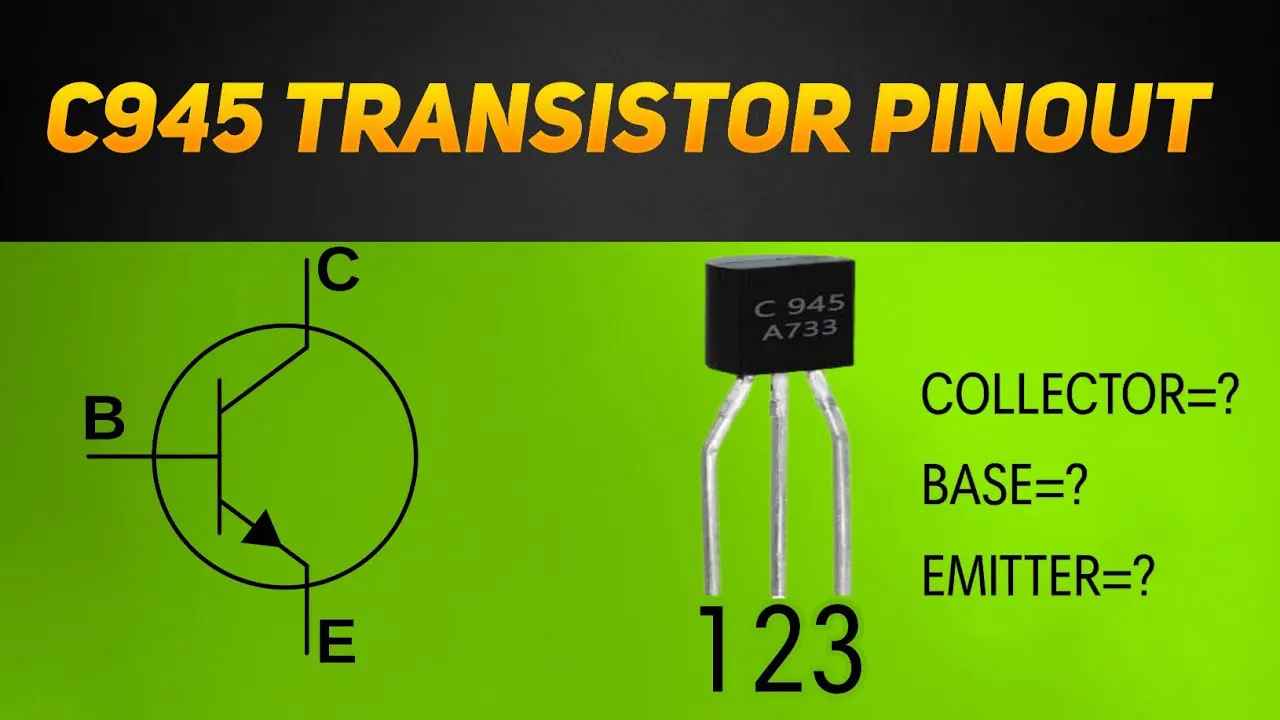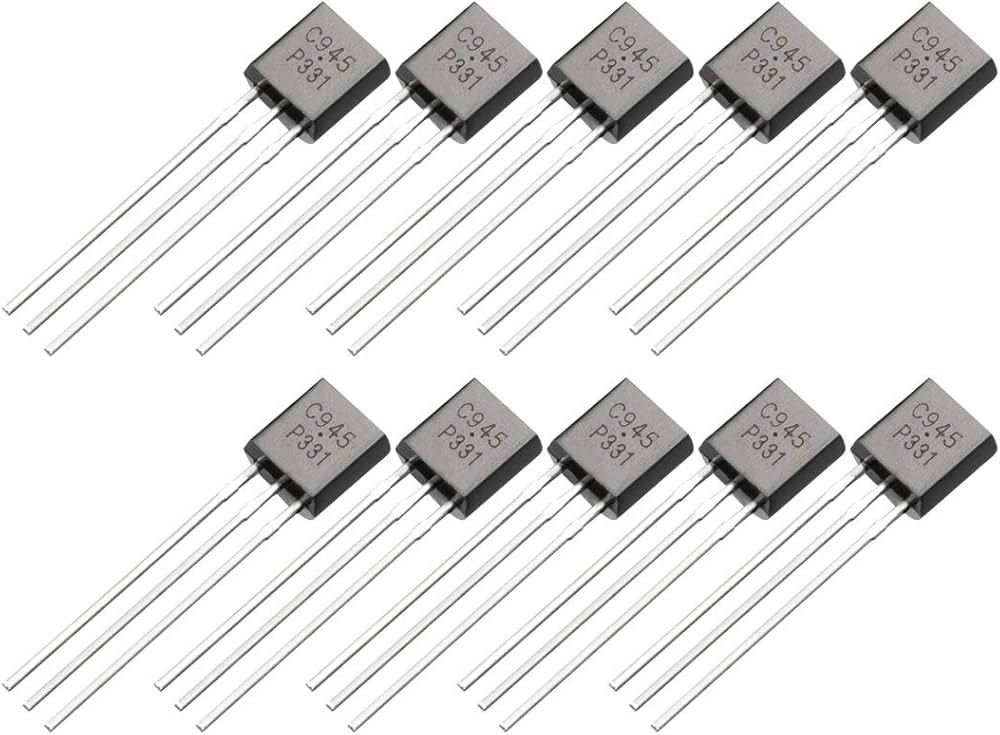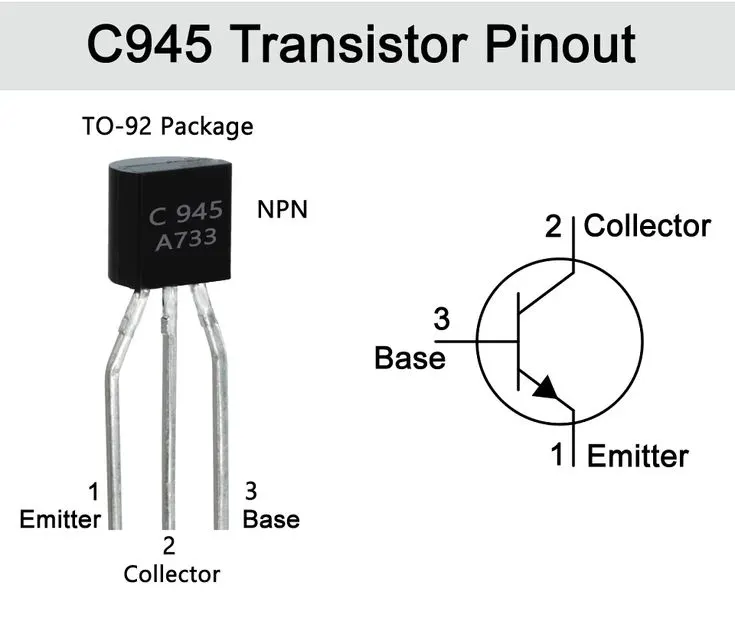
Transistors are the cornerstone of modern electronics, functioning as essential switching and amplifying components. Among the wide range of bipolar junction transistors (BJTs), the C945 transistor stands out for its versatility, affordability, and ease of use. Whether you're a hobbyist building a DIY amplifier or an engineer designing a signal-processing circuit, understanding the C945 transistor can help you make more efficient and reliable designs.
In this comprehensive guide, we will dive deep into the C945 transistor, covering everything from its definition, pinout, and specifications to usage scenarios and replacement options. We'll also explore its datasheet and provide answers to some of the most commonly asked questions.
C945 Transistor Definition

The C945 is an NPN bipolar junction transistor (BJT) primarily designed for low-frequency, low-power amplification and switching applications. Originally produced by Toshiba, it has become a de facto standard in many analog circuit designs due to its widespread availability, affordability, and well-rounded performance characteristics.
Being an NPN-type transistor, the C945 operates by allowing current to flow from the collector to the emitter when a small current is applied to the base. This simple three-layer structure is the cornerstone of most logic and analog signal systems. As a general-purpose transistor, the C945 is used extensively in audio pre-amplifiers, signal amplifiers, voltage regulators, and basic switching circuits.
In essence, the C945 offers a cost-effective solution for designers seeking stable performance in applications where high-frequency operation and high-current throughput are not critical. Its balanced specifications make it ideal for educational kits, prototyping boards, and budget-sensitive designs.
C945 Transistor Features
The C945 is an NPN bipolar junction transistor (BJT) housed in a TO-92 package, commonly used for low-power switching and signal amplification. It supports a maximum collector-emitter voltage of 50V, a collector current of up to 150mA, and features a high DC gain (hFE) ranging from 70 to 700, with a transition frequency around 150MHz. Known for its low noise and fast switching speed, it's ideal for audio and high-frequency applications.
The C945 transistor comes with a set of features that make it a go-to solution for general-purpose electronic design. Some of the notable features include:
• Transistor Type: NPN
• Collector-Emitter Voltage (Vceo): 50V
• Collector-Base Voltage (Vcbo): 60V
• Emitter-Base Voltage (Vebo): 5V
• Collector Current (Ic): 150 mA max
• Power Dissipation (Pc): 400 mW
• DC Current Gain (hFE): 70 to 700 (depending on model and manufacturer)
• Transition Frequency (fT): 150 MHz
• Low Saturation Voltage: Ensures minimal energy loss during switching
• Low Noise Output: Suitable for audio and signal applications
These features enable the C945 to deliver consistent results in low-power amplification and signal switching circuits. For example, its relatively high hFE (gain) makes it suitable for preamplifier stages, while the moderate Ic rating allows it to switch small loads such as relays or indicator LEDs.
C945 Transistor Pinout

The C945 transistor has three terminals, each serving a specific function. Here is the pinout configuration of the C945 transistor:
1. Emitter (E): The emitter terminal is typically denoted by an arrow symbol on the transistor package. It is connected to the N-doped layer of the transistor and is responsible for emitting electrons or carrying the output current.
2. Base (B): The base terminal is the control terminal of the transistor. It is used to regulate the current flowing through the transistor by controlling the input signal. The base terminal is usually the center pin of the transistor.
3. Collector (C): The collector terminal is connected to the P-doped layer of the transistor. It acts as the output terminal, allowing the flow of current from the emitter to the collector. The collector terminal is often connected to the positive supply voltage in most circuits.
Correctly identifying the pinout of a transistor is essential for circuit integration. The C945 transistor, typically housed in a TO-92 package, has the following pinout when viewed from the front (flat side facing you):
| Pin Number | Name | Function |
|---|---|---|
| 1 | Emitter | Connects to ground or negative |
| 2 | Collector | Connects to load |
| 3 | Base | Receives input signal |
Understanding the pinout is crucial during prototyping and soldering. Reversing connections can lead to circuit malfunction or permanent damage to the transistor. Many datasheets and online resources include a diagram to help clarify this orientation.
The base pin controls the transistor’s behavior. A small input current to the base allows a larger current to flow from the collector to the emitter. This current amplification makes the C945 ideal for signal gain applications.
C945 Transistor Package
The C945 transistor typically comes in a TO-92 package, which is a small, plastic, through-hole casing commonly used for low-power transistors. This package is compact, easy to handle, and ideal for prototyping or circuit board mounting, with three leads for the collector, base, and emitter terminals.
The physical design and packaging of a transistor determine its suitability for different mounting techniques and environments. The C945 comes in a TO-92 package:
TO-92 Package Details:
• Dimensions: Approx. 4.5 mm width, 5 mm height
• Lead Pitch: 1.27 mm
• Lead Length: 14 mm (standard)
• Encapsulation Material: Molded epoxy
• Mounting Type: Through-hole
This package is compact and cost-effective, widely used in breadboards, stripboards, and printed circuit boards (PCBs). It’s easy to handle and solder, which makes it an excellent choice for both professional engineers and electronics hobbyists. While it offers limited power dissipation, it is more than adequate for the C945’s intended use cases.
The TO-92 package does not provide heatsinking capability, so care must be taken to avoid thermal overloading. In high-ambient-temperature environments, it's recommended to use components with better thermal characteristics or provide additional cooling mechanisms.
C945 Transistor Equivalent Parts
While it's always recommended to use the exact specified transistor for a given circuit, there are some equivalent transistors that can be used as substitutes for the C945 transistor. These equivalents have similar characteristics and can be interchanged in many applications.
When designing or repairing circuits, it may be necessary to substitute the C945 with an equivalent transistor due to supply constraints, cost considerations, or specific circuit requirements. Below is a list of common alternatives:
| Equivalent Part | Type | Vceo | Ic | hFE Range | Package | Notes |
| 2N3904 | NPN | 40V | 200mA | 100–300 | TO-92 | Popular general-purpose option |
| BC547 | NPN | 45V | 100mA | 110–800 | TO-92 | Lower current handling |
| 2N2222 | NPN | 40V | 800mA | 100–300 | TO-92 | Higher current capacity |
| 2SC1815 | NPN | 50V | 150mA | 70–700 | TO-92 | Nearly identical to C945 |
| S9014 | NPN | 50V | 100mA | 100–400 | TO-92 | Good match for audio circuits |
While choosing an equivalent, it’s important to match not only voltage and current ratings but also gain and frequency response. For example, while the 2N2222 offers higher current handling, it may not perform as well in audio applications where low noise is crucial. These equivalents are best chosen based on the specific application—such as audio amplification, switching, or signal processing—to ensure optimal performance. Always double-check datasheets before substitution to confirm compatibility.
C945 Transistor Usage
The C945 transistor is commonly used in audio amplifiers, signal boosters, and low-current switching applications due to its high gain and low noise characteristics. It’s ideal for circuits such as preamplifiers, oscillators, voltage regulators, and sensor interfaces. Its versatility makes it a popular choice in both hobbyist projects and commercial electronics.
The C945’s flexibility allows it to serve in a multitude of electronic applications. Here are some common usage scenarios:
1. Audio Pre-Amplification
C945 is extensively used in low-noise audio preamps, tone control circuits, and equalizers. Its high gain and low distortion make it suitable for boosting weak signals from microphones or musical instruments.
2. Signal Amplification
In RF and analog circuits, the C945 amplifies weak signals before processing. It's often found in intermediate-frequency (IF) and RF stages of radios and communication devices.
3. Low-Power Switching
The transistor’s 150 mA current capacity enables it to switch small loads, such as relays, buzzers, and indicator LEDs. It's ideal for microcontroller-based systems where direct driving is impractical.
4. Oscillator and Timer Circuits
C945 plays a key role in oscillator circuits, such as Colpitts and Hartley oscillators, where it helps in waveform generation and timing control.
5. Voltage Regulation
It’s also used in voltage regulation circuits as a pass transistor, working alongside Zener diodes to maintain a stable output.
C945 Transistor Datasheet
A datasheet provides detailed specifications essential for correct application. Below is a summarized version of the C945 transistor’s key data:
| Parameter | Value |
| Type | NPN |
| Package | TO-92 |
| Collector-Emitter Voltage (Vceo) | 50V |
| Collector-Base Voltage (Vcbo) | 60V |
| Emitter-Base Voltage (Vebo) | 5V |
| Collector Current (Ic max) | 150 mA |
| Total Power Dissipation (Pc) | 400 mW |
| DC Current Gain (hFE) | 70 – 700 |
| Transition Frequency (fT) | 150 MHz |
| Operating Temperature Range | -55°C to +150°C |
For complete details, including characteristic curves, S-parameters, and thermal resistance, refer to the full c945 transistor datasheet here.
Where to Buy C945 Transistor?
The price of a C945 (2SC945) transistor varies depending on the package type, quantity, and supplier. It typically ranges from $0.01 to $0.10 per unit in bulk, while individual units can cost around $0.05 each. Bulk purchases or surface-mount versions may offer even lower prices, making it a cost-effective choice for both hobbyists and manufacturers.
Whether you're a large-scale manufacturer or an individual hobbyist, sourcing authentic C945 transistors is crucial. Here are some of the best options:
Online Distributors:
• AIChipLink.com – Specializing in electronic component distribution globally, AIChipLink offers competitive pricing and quality assurance.
• Digi-Key – Offers fast shipping and a wide inventory of components.
• Mouser Electronics – Known for reliability and datasheet availability.
• RS Components – Provides high-quality components with professional packaging.
• AliExpress & eBay – Ideal for small quantities but verify seller reputation.
• Amazon – Convenient for local deliveries, especially in small packs.
When buying electronic components, always verify part authenticity, date code and shelf life, ESD packaging, and manufacturer details—and for bulk orders, request traceability and compliance certificates to ensure you're using genuine parts in your designs.
Conclusion
The C945 transistor is a staple in the world of electronics, prized for its versatility, affordability, and ease of use. From audio amplifiers to switching relays, its applications are as varied as they are impactful. Understanding its specifications, pinout, and equivalent components ensures that you can make informed design choices that enhance circuit reliability and performance.
Whether you’re repairing legacy hardware, building a prototype, or teaching students the basics of transistor operation, the C945 offers a practical solution with a proven track record. Be sure to check out AIChipLink.com for reliable sourcing options and additional resources on integrated circuits, transistors, and other critical electronic components.
FAQ About C945 Transistor
Q1: Is C945 NPN or PNP?
A: The C945 is an NPN transistor. It allows current flow when a small current is applied to the base terminal.
Q2: Can I use 2N3904 instead of C945?
A: Yes, 2N3904 is a close match in many parameters and can be used in most circuits that require a C945. However, double-check the current ratings and gain values.
Q3: What is the maximum voltage for C945?
A: The maximum collector-emitter voltage (Vceo) is 50V, and the collector-base voltage (Vcbo) is 60V.
Q4: What is the gain (hFE) of a C945?
A: The DC current gain can vary between 70 and 700, depending on the specific model and manufacturer.
Q5: How do I know if a C945 is working?
A: Use a digital multimeter in diode mode to check base-emitter and base-collector junctions for voltage drops (~0.6V). If the readings are abnormal or the junctions are short/open, the transistor is likely faulty.
Q6: Is C945 suitable for power applications?
A: No, the C945 is not designed for high power use. Its max collector current is 150 mA, so it is suitable for low-power signal amplification and switching only.
Read More:
• NVIDIA Computing Power GPU Main Part Number and Parameters
• How Good is the NVIDIA GeForce RTX 50-Series for AI?
• Nvidia GeForce RTX 5070 Ti vs. AMD Radeon RX 9070 XT, which one is better?
Written by Jack Zhang from AIChipLink.
AIChipLink, one of the fastest-growing global independent electronic component distributors in the world, offers millions of products from thousands of manufacturers, and many of our in-stock parts is available to ship same day.
We mainly source and distribute integrated circuit (IC) products of brands such as Broadcom, Microchip, Texas Instruments, Infineon, NXP, Analog Devices, Qualcomm, Intel, etc., which are widely used in communication & network, telecom, industrial control, new energy and automotive electronics.
Empowered by AI, Linked to the Future. Get started on AIChipLink.com and submit your RFQ online today!










.png&w=256&q=75)


